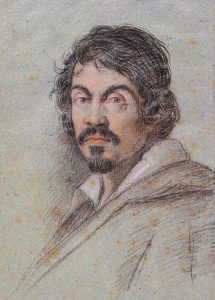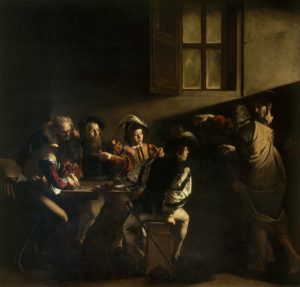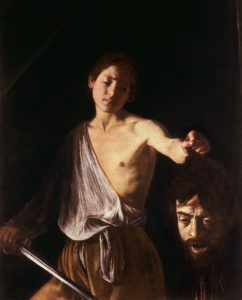Earlier in the year, I wrote a piece on the British landscape painter J.M.W. Turner and his impact on modern art. Turner was known as a technical innovator, applying watercolor techniques to the medium of oil painting, achieving colors and textures that earned him the nickname 'The Painter of Light'. But if Turner is the Painter of Light, then it only makes sense for me to recognize the Master of Darkness: one of my favorite Old Master painters, Michelangelo da Caravaggio.
There are many artist archetypes, and many of them have a basis in reality. Michelangelo Buonarroti was the obsessive, while Leonardo was the procrastinator. Van Gogh and Pollock were both wily recluses, Raphael was the lover who died young, and Picasso was the cantankerous, abusive genius. Caravaggio, however, falls into a different category, one that very few people other than himself inhabit. He was the hot-headed bad-boy artist whose inner turmoil spilled onto his canvases. He was one of the major figures in the Catholic Counter-Reformation. To fight against new Protestant religious sects in Europe, the Catholic Church commissioned artists to create works that would reach out to common people and serve more or less as propaganda. Caravaggio did this by combining biblical stories with the aesthetic of daily life in sixteenth- and seventeenth-century Italy. While this was not uncommon during the Baroque period and previous eras, Caravaggio combined this artistic convention with a style with which his name has become inextricably linked: chiaroscuro.
Meaning light-dark, chiaroscuro is the intense contrast between light and dark in a work. In his paintings, many of his subjects almost seem to be emerging from complete darkness. This often made his works dramatic and intense in a way that had never been seen before. Only fifty years before Caravaggio’s birth (on September 29, 1571), the masters of the High Renaissance revived the classical ideal through their paintings and sculptures. Raphael and Michelangelo elevated the human form and the human experience. But by the time Michelangelo da Caravaggio came around, he was finding light and truth by delving down into the world's dark places.
One of his most famous works, The Calling of Saint Matthew, shows the biblical story of Christ inspiring the tax collector Matthew to become one of his disciples. Many artists had previously put the scene to canvas, but never like this. Matthew sits with other tax collectors at a table, poring over their coins. He and his companions sit in what looks like a shadowy tavern, probably not unlike the ones scattered throughout Rome in the late 1500s, ones that the painting’s viewers would be intimately familiar with. Christ enters on the right, shrouded by darkness, raising his hand to point at the tax collector at the table. The line marking where the shadow ends and the light begins seems to follow the line of Jesus‘s finger, which leads directly to Matthew. This is the moment when Jesus asks Matthew to follow him, yet immediately before Matthew recognizes Christ and gets up from his table. Matthew sees Christ and points to himself as if to say, “Me?” Christ is shown as a light source in some religious paintings, yet here, he is in darkness but causes the illumination and enlightenment of others.
Caravaggio was a man of the streets. He spent his time in taverns drinking, mingling with prostitutes, dueling those who insulted him with his sword. It’s unsurprising that he often used the people on the streets as his models. His Death of the Virgin is probably the epitome of this practice. Normally, during the Renaissance, artists stopped showing the Virgin Mary’s death and preferred to show her assumption, her rising and being welcomed into heaven. Such subjects had been executed by El Greco, Correggio, Fra Bartolomeo, Dürer, and Titian, among others. However, Caravaggio decided to revive the earlier convention of not showing her elevated and in glory, but rather as a mortal person. He depicts the Virgin lying across a bed in a red dress. A group of figures gathers about, some mourning while others talk among themselves. The men are somewhat obscured, while the unseen light source in the upper left mostly illuminates Mary’s body. Her skin is pale, and her limbs are limp and lifeless. She is no longer the Virgin Mary; she is just a woman who has recently died. Stories say that Caravaggio used the body of a dead prostitute fished out of the River Tiber as his model.
His vices and his faith collided on the canvas. Towards the end of his life, this became ever more apparent as he was on the run after killing a man in a duel. As an interesting form of penance, Caravaggio created one of his most interesting works, at least in my opinion, that of David with the Head of Goliath. He actually made two versions of this painting, but the one now housed in the Galleria Borghese in Rome is far more interesting. It is thought to be a double self-portrait, with the likeness of his younger self holding up the decapitated head of his debauched, sinful, older self. It’s a poignant mea culpa transferred to the canvas.
Unfortunately, Caravaggio died in 1610 at the age of 38 from what is thought to have been lead poisoning. He collapsed alone on a beach in Tuscany, still on the run with a price on his head. Many great artists, like Raphael, Van Gogh, and Basquiat, died before they perhaps should have. And like with them, we will never know how much more Michelangelo da Caravaggio would have contributed. We do not know to what extent art today would be different had his own personal darkness that made him brilliant and infamous not cut his life short.




